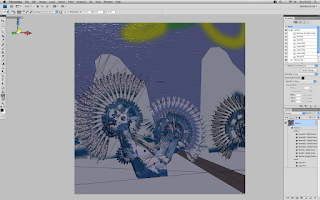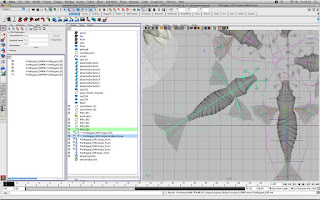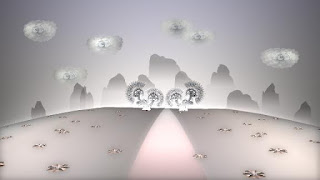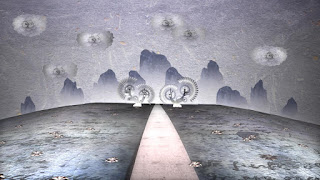















The reason we haven't added to the blog in a while is that we were simply all busy with work.
There are now just under 3 weeks left until the term is over and university is finished and the film has come a long way since the last post, as with all movies there have been a few small bumps in the road but everything seems to have been sorted for now. Some of the problems are due to software, others due to bad communication, whilst other are just as simple as people not knowing the best way of doing things. University is all about
learning and experimenting so as a group together weve all slowly progressed through the year.
This post will just be a brief synopsis of the work being produced so far, thought this could be split into several rather large timetable postings...nobody has the time to do so.
What was done so far by whom:
According to BBC Guy's advice we decided to do some minor changes to the story in order to make it more clear. We cut out a lot of running scenes and the main change- we decided to get rid of montage to make time more linear and more understandable for the viewer (so he or she doesn't lose the red line). Richard said we need to make cear what is the character fighting for (to make 1000 paper cranes to be granted a wish and run again), which needs to grow into something bigger- fight for world's peace.
Modeling is done:
AJDIN decided not to cooperate in our group, which he announced at the end of term 2, way too late for the normal flow of the group and just at the time when everyone was busy with dissertation. As a result Anja modelled all the scenes originally assigned to him in a very short time.
All the rest of the group handed in animation in a time decided:
Heba- all the hospital scenes. She did a good job modeling, but forgot to sort out the uv's and did the whole lighting.
Dan- his scene was cut out (the flowerfields, although he tried to model it). Instead of that he did other jobs.
Mehmet- finaished his bamboo bridge scene, a beautiful complex fish eye scene, also cut out later.
Louis: Modeled his Red sun scene surprisingly well.
TEXTURING:
Anja did the texturing of all the scenes. It actually took long to figure out the right way as she wanted to preserve some of the effects like ramps, glows, specular shading, play around different transparencies.
We chose to do everything with PSD networks. We came to conclusion that instead of having all textured with the same white paper (which we tried and looked quite boring), would be better to use different kinds of paper.
It was hard to get all the textures in high resolution, so Anja often photographed them herself.
More about texturing on her blog.
LIGHTING
Anja sorted out all the lighting which was extremely hard job as all is LIGHT LINKED. The reason for that is that she wanted to achieved a certain look which would be more crisp in case of scenes that are going on NOW (at the time of speaking) and the scenes, where the main character is imagining the past events soft lights creating dream like effect of fog and reflections in the water).
A lot of objects (lights in the hospital scenes for instance) are actually enlightened within themselves with the help of glow, incandescence and specular. shading.
RIGGING of 3D elements:
Moe: The 3D fish was rigged very well by Mohammed Warsame. Great job!
Dan rigged the clocktrees: As Dan put later in the blog- these were really hard to ruig as the geometry isn't too clear, but he succeeded.
Louis rigged the branches in the Red sun scene... 57 joints in one branch...hmmm hmmmm. He said he will animate them himself and we were all very happy with that. Thanx Louie!
The Lotus flowers in the Puddle scene- rigged by Simon.
3D Animation:
Simon: animated most of the objects in 3D scenes: Fish he animated with the help of the bezier spline, when the object in the scene is animated according to the curve. He encountered the problem when asked to change the timing- the spline deformed. We fixed the problem in the animation editor. Simon animated the reference objects, not the actual obects , which made the scene less heavy and animation thus more efficient.
He also animated the cranes to appear when camera dollys through the room. the cranes are referenced from another scene and all of them slightly rotate in a different way.
Louie animated his branches as perviously said.
Dan animated the clocktrees to run out when the reference object passes by on a bezier curve.
2D Animation :
All the 2D animation has been done by Anja and Heba. To help the imagination, we filmed and photographed the reference. This really helped the perception of very hard to imagine perspective angles and body deformations (shortening,...), to foresee the distances between objects in the backgrounds and to get the general feel.
Anja filmed the references already in a Term 1, but his time her end Dan did it more precise.
INKING:
The most important is not to loose the continuity in the film with binging together two completely different concepts of animation- 2D and 3D. inking needs to be very strong and precise. The edges of the animation refined, so they melt finely with the environment. The sizes of the charecters animated in 2D need to match perfectly with 3D camera moves and textures in 3D environments. In clocktrees scene we decided to project2D animation on an animated flat plane as a texture, so it matches completely. This requires a lot of experimenting.
NEW COLOUR FEEL
The " real scenes that are happening "now" we decided to do more crisp and clear as the ones where the main character imagines how it was before. The bomb scene from her childhood is therefore black and white with a grainy effects, to look more "imaginary". The hands holdng a child are blue and radiating, which might help to clear the possible confusion who is the child they are carrying (young Sadako and not her baby!).
Wit the coloring of the skin, textiles and hair Anja wanted to achieve the feel of flash, light reflections, the beauty of watercolor technique and make a step closer to Japanese tradition.
All the scenes are based on a contrast between Blue and Red, the symbolic color of geisha. Read about their meanings in older posts on this blog.
Scenes of suffer are more darkish mysterious, the imaginative are more white, virginal, like a clear unspoiled soul of a child, a victim in a war.
CAMERA MOVES AND TIMING:
Before animating Dan and Anja once more agreed on all the camera moves. These were tried out when they did photo and filming reference in the week 3.
RENDERING
In order to have more control over the objects we decided to render out everything in layers. To do so, all the scene needs to be sorted out, assigned to layers which makes it easier to render them out at the same time.
SPECIAL EFFECTS
Charlie-was trying out really hard for quite some time to animate the city explosion and particle animation in Maya. He was not very successful as the modeling with illustrator left very confusing polygon structure and this one was hard to animate., so we dropped that idea soon.
Anja-Instead of him, Anja solved the problem with making the explosion in After Effects. She also find the solution for creating the fog iand reflections in Maya.
POSTPRODUCTION
cutting out the 2D animation and matching it with the 3D appearance
THE SOUND DESIGN
Papery feel, keeping the old melody, surround, new voice over.
THE CREDITS
Here are the timings for the scenes:
Scene 1 - Bed Scene has now been cut from almost 20 seconds to 13 seconds.
Scene 2a - Bomb Scene - 00:30 - 01:02
Scene 2b - Bomb Explosion - 1:02 - 01:15
Scene 3 - Mourning Scene - 01:15 - 01:30
Scene 4 - Closeup eye shot - 01:30 - 1:46
Scene 5 -Window (Side View to back view then Zoom into the Red sun outside the window).
Scene 6 - Running Scene +Red Sun (Distance)
Scene 7 - Puddle (Birds Eye view)
Scene 8 - Jump Upwards (Top view)
Scene 9 - Foot lands in the puddle - View changes to side view
Scene 10 - Jump over the puddle - Zoom out of red Sun
Scene 11 - Return to Window View (Side Angle) - 1:47 - 1:48 (May possibly Change to 8 seconds long).
Scene 12 - Zoom into the Crane
Scene 13 - Crane falls and Sadako Catches it - 02:04 - 02:06
Scene 14 - Sadako with the crane in her hand looks out happily.
Scene 15 - Camera Dolly scene in the hospital with Sadako making the cranes
Scene 16 -Sadako's family stands by her side begging her to rest as she is getting progessivly worse.
Scene 17 - Sadko finishes some cranes but cannot sit up straight any longer
Scene 18 - Clocktree Scene
Scene 19 - Sadako tires and her head begins to fall downwards in a slump
Scene 20 - The clocks stop as Sadako PASSES( symbolising the lack of time left for her)
Scene 21 - Camera zooms out of the Crane in Sadakos hand and the viewer can see she has passed away
Scene 22 - A shot from underneath a flying crane.
Scene 23- Inscription- a campaign against atomic weapons.



















